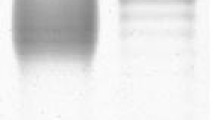Abstract
Lipopolysaccharides (LPS) ofSalmonella typhi strains, isolated from carriers and patients suffering from typhoid fever, were characterised according to their biochemical properties, morphological structure and degree of aggregation of complexes. All preparations of LPS, regardless of their origin, were morphologically heterogeneous. Free electrophoresis and immunoelectrophoresis demonstrated that LPS preparations were composed of components possessing different mobilities in electric fields. LPS of bacterial strains isolated from both carriers and patients, split upon reaction in immunoelectrophoresis with specific antiserum 73, rabbit antiserum toSalmonella typhi Vi Bhatnagar and 0–901 split into anodic and cathodio fractions. The anodic fraction reacted similarly as Vi antigen. LPS fromSalmonella typhi Ty-2 yielded only the cathodic fraction, typical for O antigen. LPS from strains whioh were passaged twice in nutritional medium possessed identical properties as LPS from fresh cultures ofSalmonella typhi. Electron microscopy revealed that LPS appears as long bands, rods, ellipsoid forms and amorphous material. Contrary to amorphous material, the bands, rods and ellipsoid forms possessed three-layer structure.
Similar content being viewed by others
References
Baker E. E., Whiteside R. E., Basch R., Derow M. A.: The Vi antigen ofEnterobacteriaceae. Puriflcation and chemical properties.J. Immunol. 83, 680 (1959)
Belaya J. A. Antigenic and virulence ofSalmonella typhi.J. Hyg. Epid. Microb. Immunol. 14, 263 (1971)
Burton A. J., Carter H. E.: Purification and characterization of the lipid A component of the lipopolysaccharides fromE. coli.Biochemistry 3, 411 (1964).
Čiznár I., Odler I., Mikulková V.: Typhoid carriers II. The study of antibodies by means of antigens isolated from R form ofSalmonella typhi and/or homologous strains ofSalmonella typhi.J. Hyg. Epid. Microb. 13, 83 (1969).
Dubois M., Gilles A. K., Hamilton J. K., Rebers P. A., Smith F.: Colorimetric determination of sugars and related substances.Analyt. Chemistry 20, 350 (1956).
Gitlin D. J.: Use of ultraviolet absorbtion spectroscopy in quantitative precipitin reaction.J. Immunol. 62, 437 (1949).
Hais I., Macek K.: Paper Chromatography. (In Czech) Publ. House Czech. Acad. Sci. (1959).
Jarvis F. G., Mesenko M. T., Tibbs K. E.: Production of Vi-antigan on a chemically defined medium by a coliform bacterium.J. Bacteriol. 80, 673 (1960).
Karolček J.: Problems of anti-typhoid imunity and protective vaccination against typhoid.Lekárske práce VII/I, SAV Bratislava, 1969.
Kljucheva V. V.: Isolation of Vi antigen fromS. typhi bacteria and study of the antigen by immunoelectrophoresis and immunofiltration.J. Hyg. 7, 444 (1963).
Lopes J., Innis W. E.: Electron microscopy of effect of polymyxin onEscherichia coli lipopolysaccharide.J. Bacteriol. 100, 1128 (1969).
Lüderitz O., Jann K., Wheat R.: Somatic and capsular antigens of gram-negative bacteria.Comprehensive Biochemistry 26 A, 105, 1968, Amsterdam 1968.
Marsh D. G., Crutchley M. J.: Purification and physico-chemical analysis of fractions from the culture supernatant ofEscherichia coli O78 K80: Free endotoxin and a non-toxic fraction.J. Gen. Microbiol. 47, 405 (1967).
Marsh D. G., Walker P. D.: Free endotoxin and non-toxic material from gram negative bacteria. Electron microscopy of fractions fromEscherichia coli.J. Gen. Microbiol. 52, 125 (1968).
Marx A., Vertes H., Petoovici M.: Disaggregation ofS. typhimurium endotoxin with desoxycholate.ZU. Bakt. 1. Abt. Orig.215, 516 (1970).
Olins A. L., Warner R. C.: Physicochemical studies on a lipopolysaccharide from the cell wall ofAzotobacter vinelandii.J. Biol. Chem. 242, 4994 (1967).
Oaskov F., Orskov I., Jann K.: Imrnunoelectrophoretic patterns of extracts from allEscherichia coli O and K antigen test strains. Correlation with pathogenicity.Acta path, microbiol. scand. Section B,79, 142 (1971).
Raška K.: Methods in Microbiology. (In Czech) State Publ. House Med. Liter., Prague (1958).
Ribi E., Haskins W. T., Landy M., Milner K. C.: Symposium on bacterial endotoxins. I. Relationship of chemical composition to biological activity.Bact. Rev. 25, 427 (1961).
Ribi E., Anacker R. L., Brown R., Haskins W. T., Malmgren B., Milner K. C., Rudbach J. A.: Reaction of endotoxin and surfactants.J. Bacteriol. 92, 1493 (1966).
Shands J. W. Jr., Graham J. A., Nath K.: The morphologic structure of isolated bacterial lipopolysaccharide.J. Mol. Biol. 25, 15 (1967).
Shands J. W., Graham J. A.: Morphologic structure and biological activity of bacterial lipopolysaccharides. In: La structure et les effets biologiques des produits bactériens provenant de germes gram négatifs.Colloq. CNRS Paris 174, 25 (1969).
Shands J. W.: Evidence for a bilayer structure in gram-negative lipopolysaccharide: Relationship to toxicity.Infect. Immun. 4, 167 (1971).
Stanislavsky E. S.:Zhur. Microbiol. Epidemiol. Immunol. (1974) in press.
Škvařil F.: Micromodification of immunoelectrophoresis. (In Czech)Chem. listy 9, 1069 (1961).
Tarmine D. F., Milner K. C, Ribi E., Rudbach J. A.: Modification of selected host-reactive properties of endotoxin by treatment with sodium deoxycholate.J. Bacteriol. 96, 1611 (1968).
Tripodi D., Nowotny A.: Relation of structure to function in bacterial O-antigens. V. Nature of active sites in endotoxic lipopolysaccharides ofSerratia marcescens.Ann. N.Y. Acad. Sci. Sci. 133, 604 (1966).
Westphal O., Lüderitz O.: Chemische Erforschung von Lipopolysaechariden gramnegativer Bakterien.Angew. Chem. 66, 407 (1954).
Westphal O., Jann K.: Bacterial lipopolysaccharides.Methods in Carbohydrate Chemistry 5, 83 (1965).
Author information
Authors and Affiliations
Rights and permissions
About this article
Cite this article
Strýčková, T., Farbakyová, G. Characteristics of lipopolysaccharides ofSalmonella typhi isolated from carriers and patients suffering from typhoid fever. Folia Microbiol 21, 21–27 (1976). https://doi.org/10.1007/BF02879002
Received:
Issue Date:
DOI: https://doi.org/10.1007/BF02879002




